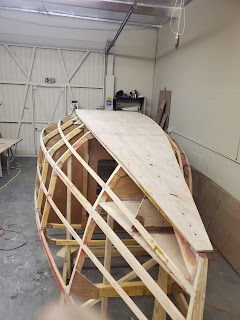Slinging Ply

Next up is epoxying and screwing down the plywood inner bottom. It's not a complex process. Put the plywood over the hull structure in the right spot, draw pencil lines around all of the stringers and ring frames. Predrill screw holes through the ply into all of the stringers and ring frames. Remove the plywood to a bench. Brush full strength (unthickened) epoxy on the ply. Then brush thickened epoxy on all of the touching stringers and ring frames. Carefully replace the ply in the right spot, and start putting screws into stringers and ring frames. Once it's fully screwed down, crawl under and wipe up all of the epoxy that squeezes out, either with a radiused tool or with a square corner. The inner bottom is the easiest, so have fun. Now for the topsides of the hull. It's also pretty easy. It is kind of installing an in an "average" way, so that there's a minimum of material to remove, and there are no gaps to fill in. ...

